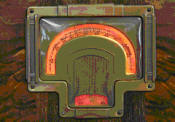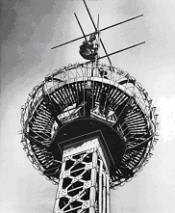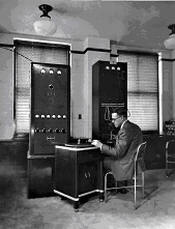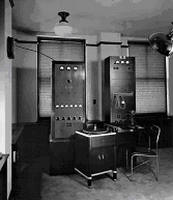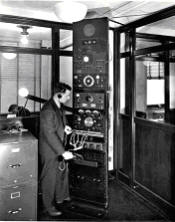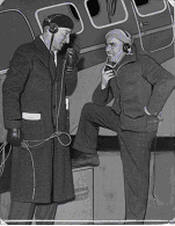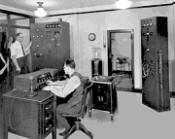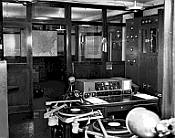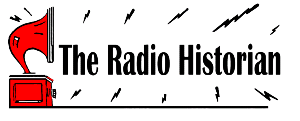
America’s Apex Broadcasting Stations
of the 1930’s
Before there was FM, there was Apex.
By John Schneider, W9FGH
www.theradiohistorian.org
Copyright 2010 -
John F. Schneider & Associates, LLC
(Click on photos to enlarge)
Dial of 1938 RCA model 15K-1 console radio, showing the “magic brain” dial tuned to the “Ultra Short Wave” band. This radio is from the author’s collection. (Photo by author)

The Penobscot Building, Detroit. W8XWJ broadcast from the spire on top of this building, which was the tallest structure in Detroit at the time. (postcard image)
W45D FM antenna 1-27-1942. The two bay turnstile antenna of W45D above the beacon on top of the Penobscot Building. The workman is Ted Ryerse. (Detroit News Archives)
W8XWJ studio/transmitter 1-30-1936. Chief Engineer C.H. Wesser at the speech input and monitoring panel of W8XWJ. The RCA 100 Watt ultra-shortwave transmitter is at left. (Detroit News Archives)
W8XWJ studio/transmitter 1-24-1936. Equipment shown (L to R): RCA 100 Watt ultra-shortwave transmitter; RCA transcription turntable; RCA speech input and monitoring panel with RCA 50A inductor microphone. (Detroit News Archives)
W8XWJ shortwave receiving and monitoring station 1-24-1936. Equipment includes (top to bottom) a Western Electric monitor amplifier and speaker; oscilloscope modulation monitor; General Radio frequency meter; National HRO receiver; Western Electric meter panel; Hallicrafters SX-10 Ultra Skyrider receiver; audio mixer and switch panel. The operator is not identified. (Detroit News Archives)
Reporters E.L. “Ty” Tyson and James V. Piersol broadcast from outside the Detroit News airplane during the inaugural broadcast of W8XWJ in Detroit - 1-29-1936. (Detroit News Archives)
Ultra Shortwave station W8XWJ Detroit 1-22-1938. C.H. Wesser, Chief Engineer, stands in front of Western Electric 500 Watt transmitter, 41,000 kHz. Engineer Carroll Leedy is at the Western Electric control console. RCA transcription turntables are at right, with the monitoring cabinet at far right. (Detroit News Archives)
Ultra Shortwave station W8XWJ Detroit 7-7-1940. Equipment shown (left to right): RCA turntables in foreground; Western Electric audio console; Western Electric 500 Watt Ultra-Shortwave transmitter. Lobby in background. (Detroit News Archives)
THE
QUEST TO IMPROVE RADIO
As radio broadcasting matured and gained importance to Americans in the 1930’s, the public became increasingly dissatisfied with the limitations of standard AM broadcasting. The principal complaints were interference, static and audio quality. The best technical minds of industry immediately set out on a quest for solutions to these issues.
In the United States, the Federal Radio Commission (later to become the Federal Communication Commission) began to consider several technical alternatives to solve these issues in 1932. Their first step was to expand the upper end of the AM band from 1500-1600 kHz. The second move was to authorize radio broadcasting on upper short wave frequencies by authorizing what it called “Apex” stations. The third and most elegant solution was ultimately the invention of Frequency Modulation (FM) by Major Edwin Armstrong and others. FM eventually became the FCC's preferred solution, and it supplanted the previous attempts to create high fidelity, “staticless” radio.
In 1927, the FRC had decided not to expand the AM broadcast band from 1500-2000 kHz, but to hold these frequencies in reserve for experimental work in broadcasting. In 1932 it created three frequencies to be used by experimental wideband “high fidelity” AM stations — 1530, 1550 and 1570 kHz. Because of the wider spacing between these three channels compared to the standard broadcast (AM) band, stations on those frequencies were able to operate with an audio frequency response up to 10 kHz instead of the usual 5 kHz. However, only four experimental stations were ever licensed for this band, all operating at 1 kW:
W1XBS 1530 Waterbury CT
W2XR 1550 Long Island, NY
W6XAI 1550 Bakersfield, CA
W9XBY 1530 Kansas City
W2XR, the most prominent of these early hi-fi stations, was the direct predecessor to today’s WQXR-FM in New York City. While the operations of these experimental stations solved some of the interference and fidelity issues of AM radio, it did not resolve the static problem.
About the same time, experiments were begun using high fidelity AM transmissions at what was then considered the upper limits of practical radio technology. Those frequencies, between 25 and 42 MHz, were called “Ultra Short Wave.” The Columbia Broadcasting System (CBS) was the first to experiment on these frequencies with experimental broadcasts in New York with 50 Watts on February 6, 1932, using the call sign W2XDV. These irregular experimental transmissions relayed the programs of WABC (now WCBS), the CBS key station in New York. The initial results were promising, and other radio engineers soon started to take notice.
Within a few years, other broadcasters also wanted to conduct research on the new frequencies, and the F.C.C. began receiving more applications for experimental licenses. F.C.C. assistant chief engineer Andrew D. Ring referred to these radio stations as “Apex” stations because of their high frequencies and high antenna locations. Broadcasting Magazine first used the word in its December 1935 issue, defining apex as being “on the highest point,” or “the highest point of a cone.” It said “these ultra high frequency stations must be located upon a high point, since their signals simulate light and must ‘rain down’ for good reception.” Because they weren’t limited to the 10 kHz channel width of the standard broadcast band, the new Apex stations could broadcast with wideband high fidelity AM.. One Apex station quoted its frequency response as being from 20 Hz to 17,000 Hz + 1 dB, with a distortion from the microphone to transmitter output of 2.5%.
Recognizing that the technology held the possibility of resolving the static and interference issues, the FCC actively encouraged the creation of these Apex radio stations. Sections 4.111-4.117 of the FCC rules governed the operations of these experimental stations. They could operate up to 1,000 watts on several groups of frequencies at 25-26 MHz and 42 MHz. These stations were not allowed to sell commercials or charge for air time, except that retransmission of a standard medium wave AM station’s programming was permitted. The stations were required to submit data on reception conditions, propagation, noise and interference, and transmission methods utilized.
Many broadcasters were interested in experimenting with this new class of radio station. As a result, by 1939, there were Apex station stations operating in 34 cities in 22 states
In technical terms, Apex stations were a cross between traditional AM broadcasters, ten meter amateur radio stations and our modern FM broadcasters. They were generally operated by standard AM broadcasters as an adjunct to their main radio operations, and most of them just duplicated the programming of their mother stations in higher fidelity.
THE FIRST APEX STATIONS
The first Apex station to operate on a regular schedule was probably W8HX, which belonged to broadcaster WBEN in Buffalo. It began operating in 1934, relaying the programs of its mother station. In January of 1936, W8HX applied for a license to operate on the frequencies of 31,600, 35,600 and 38,600 kHz.
W2XDV, the original experimental CBS station in New York, also began broadcasting its programs on a regular schedule on 31,600 kHz on November 3, 1935.
On January 29, 1936, the Detroit radio station WWJ, which was owned by the Detroit News, inaugurated its Apex station W8XWJ on 31,600 kHz. The studio and antenna were located on the top floor of the Penobscot Building, one of the tallest structures on the Detroit skyline. A 100 watt RCA transmitter fed two crossed dipole elements mounted above the decorative ball on top of the building’s rooftop spire. The programming was a simulcast of the regular WWJ programs.
The Detroit News pulled out all stops to publicize W8XWJ’s inaugural broadcast. Sportscaster Ty Tyson and Detroit News’ aviation report James Pierson transmitted live via a shortwave link from the newspaper’s airplane “The Early Bird” and gave listeners a birds-eye view of the new WWJ 5 kW AM transmitter plant, which was then nearing completion. The signals from the plane were carried live over W8XWJ, and then received and rebroadcast over the AM band on WWJ.
In Milwaukee, the Milwaukee Journal newspaper’s AM station, WTMJ, had been operating an experimental low-definition mechanical scan television station using the call sign W9XD since 1931. In 1933, the W9XD transmitter was taken off the air and converted into an Apex band transmitter. It debuted as Apex station W9XAS on 26.4 MHz in 1934, rebroadcasting the daily WTMJ programs.
In January of 1937, The Milwaukee Journal took the bold step of separating W9XAZ from its AM cousin, and it became the first (and perhaps only) Apex station to originate its own programs. As Broadcasting Magazine reported in the following months, W9XAS originated a series of live high-fidelity remote broadcasts, including a two-hour testimonial dinner for UW Head Coach Harry Stuhldreher from the University of Wisconsin, and also broadcast the season’s entire Marquette University basketball schedule. Transcribed (recorded) programs were broadcast to fill out the shortwave station’s remaining program schedule.
WTMJ technical Director D.W. Gellerup established a team of “spotters” in the area in 1937 to send weekly reception reports back to the station. These reports were compiled into a report for the F.C.C which documented the station’s reception performance. The Journal estimated that W9XAZ, operating with 500 Watts, had an effective service radius of about 25 miles. It estimated that 5,000 receivers within the coverage area were capable of receiving the 26.4 MHz signal.
THE RECEIVER PROBLEM
WTMJ’s receiver estimate was perhaps overly optimistic. Until the late 1930’s, most broadcasters were reluctant to invest this much money into broadcasting on the Apex bands because of the lack of commercially-available receivers. The tuning range of the typical all-band radio receiver of the mid 1930’s stopped at about 20 MHz, and so early listeners to Apex stations had to build their own receivers. Some of them made complete radios but most of them just built front-end frequency converters for use with conventional radios. The latter solution was the most economical, but the benefits of high fidelity transmission were lost in the process. In 1937, The Milwaukee Journal ran a contest in its pages and over the air on W9XAZ offering a prize for the best design of an inexpensive shortwave converter that could be mass-produced by the station.
Finally, starting in 1937, several radio manufacturers began to introduce models that could tune all the way up to the Apex bands. The Raco R-S-R Clipper and several McMurdo Silver models were among the first. That same year, RCA introduced its “Magic Brain” series of receivers which had a top band that tuned up to 60 MHz. These early radios proved to be insensitive and unstable at those rarified frequencies.
OTHER STATIONS
As receivers started to appear on the market, the number of Apex stations also started to grow, as other broadcasters began to show interest in the Apex station and apply for experimental licenses. W1XPW in Meriden, CT, (WDRC) began operating on 40.3 MHz in 1936. In 1937, WCHS in Charleston, WV, was authorized to operate in the 26 MHz band, and KGFJ in Los Angeles received permission to experiment on 88, 120, 240 and 500 MHz; General Electric in Albany, NY was authorized on 31.6 and 41.0 MHz. 1938 saw a license issued to WBOE in Cleveland for 500 Watts on 41.5 MHz. W1XER also began operations from Mt. Washington on 42.3 MHz that year. In 1939, Crosley’s WLW in Cincinnati began broadcasts over W8XNU on 25.95 MHz with 1,000 watts.
Despite this activity, broadcasters clearly did not have a business plan in mind for these new Apex stations. They were driven to jump into the new technology by their engineers’ enthusiasm for experimenting with new technologies, and by managements’ fears of being left behind in the forward march of technology.
PROPAGATION
The F.C.C. felt these frequencies were a good choice for high fidelity broadcasts because it was an unused part of the radio spectrum that had relative immunity from static interference. They felt each station would have a limited local range, which would allow reuse of the same frequencies in different regions without the stations causing interference to each other. However, not much was known about the propagation characteristics at 25-40 MHz in the early 1930’s.
As today’s ten meter ham radio operators know very well, propagation conditions on the frequencies that were used by the Apex stations vary tremendously over the eleven year sunspot cycle. The sun was just coming out of a sunspot minimum when the first Apex experiments began in 1932, so the new stations probably experienced mostly interference-free coverage during their first few years of operation. But sunspots were at their peak in 1936, and suddenly the experimental Apex stations were being heard all around the globe. W9XAZ in Milwaukee reported that its signal was stronger in Los Angeles than was the local station. Requests for QSL cards became coming in from all over the world, especially England and New Zealand.
THE FCC REGULATES THE VHF BAND
The FCC’s solution to the Apex band’s interference issues was announced in October of 1937. The plan was to channelize the VHF band, creating 16 channels in the 30-40 MHz range for relay stations, and 75 channels from 41.02 to 43.98 MHz separated by 40 kHz. The next year, the FCC reserved 25 of these 75 channels for educational stations. Stations were to use amplitude modulation unless they could show a need to operate with the experimental and still unproven Frequency Modulation (FM) method.
FM TESTS PROVE SUCCESSFUL
Major Armstrong first demonstrated his new “Staticless” FM technology to executives of RCA in 1934, and he described it in a paper published in the Proceedings the Institute of Radio Engineers in 1936. It was created to be another solution to the same issues of broadcasting fidelity, static and interference. It offered about the same high fidelity advantage as Apex broadcasting but was the first technology to effectively eliminate static interference. Static and electrical noise is amplitude modulated, but Armstrong’s new method transmitted audio information by creating minute instantaneous changes to the transmitter frequency. FM receivers do not detect the signal’s amplitude, effectively ignoring all static in the process. Additionally, the well known “capture effect” of FM reception eliminated most cases of interference caused by weaker stations operating on the same frequency.
Despite these demonstrated advantages, industry leaders remained sceptical about the technology. RCA executives and other entrenched broadcasters, in particular, were fearful of the economic impact that would be caused by upsetting the status quo of the very profitable AM broadcasting business. F.C.C. engineers were also unsure of FM’s capabilities, but nonetheless they authorized a few experimental licenses. W1XOJ in Paxton, Massachusetts, operated by the Yankee Network, received the first experimental FM construction permit on August 18, 1937. The Yankee Network built an FM station on the top of Mt. Washington in New Hampshire, and then Major Armstrong built his famous FM station W2XMN in Alpine, NJ. Most of these early FM stations operated in the 42 MHz band, sharing spectrum with the existing Apex stations.
In January, 1939, the F.C.C. sent out a team of engineers to investigate the Armstrong FM station W2XMN, which was transmitting with 20 kW on 42.8 MHz. They listened to the station 50 miles from the transmitter site in Sayville, NJ. . They also heard FM station W2AG from Yonkers, operating on 110 MHz with 500 Watts. They came back clearly impressed with the results of the demonstration. Further tests demonstrated FM technology’s clear superiority to AM.
In February of that year, an article in Broadcasting Magazine quoted the FCC’s praise of FM. The FCC said that its tests showed that FM demonstrated “a material gain in effectiveness of reception through static, especially the type of static resulting from nearby thunderstorms and from some types of man-made electrical disturbances.” The article said the FCC wanted to expedite FM testing before the Apex AM broadcasters could become too well entrenched.
THE FCC ENCOURAGES APEX STATIONS TO CONVERT TO FM
Major Armstrong made history on July 18, 1939, when he began regular commercial broadcasts on W2XMN. The first live classical music program originated at WQXR’s New York studios and was conveyed to Alpine, NJ over special high fidelity phone lines. There were not many listeners because there were only 25 FM receivers in the world at that moment. But the privileged few who heard it all agreed on one thing — they had just witnessed a revolution in radio broadcasting.
The FCC conducted a series of hearings about FM during March and April of 1940. The often contentious proceedings pitted the proponents of Armstrong’s wideband FM system against RCA and other interests who a favored narrowband FM approach that left more spectrum for the development of television. Its decision, announced on May 20, was a complete victory for the Armstrong interests and a major setback for RCA and the television interests. The Commission approved thirty five 200 kHz wide channels above 43 MHz for FM, reassigning TV channel 1 for FM radio. It announced that FM would be the modulation method to be used for television sound.
A wave of FM excitement quickly took over the industry, and the FCC was immediately deluged with 150 applications for FM stations. Three transmitter manufacturers and numerous receiver manufacturers announced FM products. Unfortunately, this first FM wave would never get off the ground before World War II brought all development to a standstill. The new FM stations hung on through the war, but the FCC’s decision in 1945 to move all FM stations to a new 88-108 MHz band would make all of these early stations and receivers obsolete. It was a setback that FM would not recover from until the 1960’s.
In its 1941 announcement, the FCC also announced that it would terminate all existing experimental high frequency licenses, both AM and FM, on January 1, 1941, and encouraged those stations to reapply for new commercial FM licenses. No AM broadcasting on the ultra-high frequencies would now be allowed. The Apex stations began shutting down or converting to FM in droves.
The first station to convert was at WTMJ in Milwaukee. W9XAZ had already been turned off by 1939 when the station applied for an experimental FM permit and a new television license. W9XAO debuted on May 15, 1940, as the first FM station west of the Alleghenies. It was programmed independently from WTMJ. Under the new regulations issued that same month, the station changed frequencies by the end of the year and became W55M.
Meanwhile, WWJ in Detroit shut down W8XWJ in April of 1940 after just over four years of operation and applied for an FM license on 44.5 MHz. The new station, W45D, was one of the first 15 commercial FM construction permits issued by the FCC in October of 1940. (W45D can be directly traced to today’s WXYT-FM in Detroit.) Like W8XWJ, the new FM station also broadcast from the top of the Penobscot Building, operating from “special acoustically treated” studios that were specially designed for FM.
It’s believed that the last Apex station to leave the air was WBOE in Cleveland, which converted to FM broadcasting in February of 1941.
SUMMARY
Today, with the benefit of hindsight, we can clearly see that Apex broadcasting was only a short-lived transitionary phase in the development of FM broadcasting. Nonetheless, at its peak near the end of 1938 there were over fifty Apex stations on the air in the country, and perhaps as many as a hundred stations had existed in total. But AM clearly paled next to the superiority of Frequency Modulation, which grew in stature until finally becoming the preeminent means of radio broadcasting in the world today. Despite the efforts of many entrenched industry interests to subvert its development, and its numerous technical and commercial false starts, the superiority and genius of Major Armstrong’s last and greatest invention ultimately could not be contained.
Nonetheless, a lot of important technical lessons were learned in the process of building and operating the Apex stations. They created a “real world” laboratory which served to establish a body of practical knowledge about the unique characteristics of VHF transmission and reception. Industry and broadcast engineers had to become familiar with VHF techniques that were vastly different than Medium Wave. Transmitters, antennas and transmission lines all worked on different principals. New issue in the creation and management of high fidelity audio had to be overcome. Propagation characteristics of the new “ultra short wave” frequencies were seriously studied for the first time. Without these valuable experiences, the development of the nascent FM broadcasting industry would surely have taken much longer.
Sources:
“Broadcasting Magazine,” 12-1-35; 2-1-36; 1-1-37; 5-15-37, 5-15-40, 6-1-40, 7-1-40
“Radio Annual,” 1938, 1939, 1940, 1941
The Detroit News, 1-29-1937
Wikipedia article: Apex (radio band), http://en.wikipedia.org/wiki/WTMJ-TV
Article: “Pre-history, Detroit’s Experimental Amplitude Modulation (AM) ‘Apex’ station W8XWJ,” http://www.michiguide.com/history/fmhistory/prehist.pdf
Article: “WTMJ-TV,” http://wapedia.mobi/en/WTMJ-TV
Article: “FM Broadcasting Chronology ,” http://jeff560.tripod.com/chronofm.html
Article: “American Apex Stations,” http://www.w4uvh.net/dxld9060.txt
Article: “1938 Raco Super-Clipper” by William Fizette, . http://www.eht.com/oldradio/awa/otb/v3301p26/v3301p26.htm
NOTE: This article appeared in the Monitoring Times Magazine, December, 2010.
